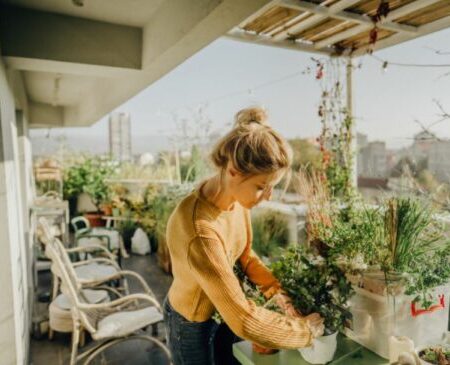Urban gardening offers city dwellers a delightful way to bring a touch of nature into their homes. Beyond enhancing your home-cooked meals, these compact green spaces improve air quality, provide a serene retreat, and promote mental well-being. Ready to turn your small urban space into a green oasis? Let’s get you started.
Designing Your Small Garden Space
First things first: what’s your space like? Most vegetables and herbs need at least six hours of direct sunlight daily. Evaluate wind exposure. Balconies and rooftops can be windy, which might affect plant health. Consider your watering options and the weight capacity of your balcony or rooftop if you plan to raise your garden there. Plan how you’ll move through the garden to care for your plants, ensuring ease of access.
Choose the Right Plants
Selecting the right plants is key to a successful urban garden. Companion planting can help you save space and enhance growth. For instance, planting marigolds with tomatoes can deter pests like nematodes, while basil boosts growth and flavor. Similarly, the trio of beans, corn, and squash complements each other perfectly:
- Corn supports beans.
- Beans provide nitrogen for corn.
- Squash shades the soil, reducing weeds.
Maximizing Space with Creative Solutions
In urban gardening, every inch counts. Utilize vertical space with wall-mounted planters, hanging baskets, and trellises for climbing plants like peas and beans. Consider stackable planters for herbs and strawberries. Window boxes are perfect for growing flowers, lettuce, and small root vegetables. Repurpose household items like old ladders, pallets, and shelves to create multi-level gardening structures. These creative solutions not only maximize your space but also add an artistic touch to your urban oasis.
Timing Your Planting
Timing is everything in gardening. Start by checking your region’s last frost date – tender plants like tomatoes and peppers can’t handle frost. Consult seed packets or local gardening resources for planting times. Cool-season crops like lettuce and spinach can be planted early in spring or late summer for a fall harvest. Warm-season crops such as beans and squash thrive in warmer soil and should be planted after the last frost. For a continuous harvest, plant a few seeds or plants at a time, staggering the planting over several days.
Select the Proper Containers
Choosing the right containers is crucial. Compact plants thrive in smaller pots, while larger plants like tomatoes or peppers need substantial containers. Ensure each pot has drainage holes to prevent waterlogging. Lightweight materials like plastic or fiberglass make pots easier to move. Utilize vertical space with hanging baskets or vertical planters for trailing plants like strawberries or herbs. Consider blending pot colors and styles with your space decor for a cohesive look.
Planting Seeds or Transplanting Plants
A well-draining potting mix is essential for container gardening. Avoid garden soil, which can be too dense. Enhance your mix with compost for nutrients and structure, and add perlite or vermiculite for aeration. Coconut coir or peat moss improves water retention, crucial for maintaining consistent moisture levels. Follow seed packet instructions for planting depth, generally placing smaller seeds shallower than larger ones.
Watering Your Plants
Water deeply and evenly to encourage root growth, especially in containers where the soil dries out faster. Use a watering can with a gentle shower or a drip irrigation system to deliver water directly to the base of plants, minimizing evaporation and runoff. Monitor soil moisture regularly by checking a few inches below the surface.
Inspect for Health Issues
Regular monitoring for pests and health issues is vital. Look out for common pests like aphids, caterpillars, and spider mites, which can harm your plants. Inspect leaves for holes, discoloration, and sticky residues. Use organic methods like hand-picking, soapy water sprays, or neem oil to manage infestations. Watch for fungal diseases such as powdery mildew or leaf spots, and improve air circulation around plants to prevent them.
Sustainable Urban Gardening Practices
Urban gardening isn’t just about growing plants, it’s also an opportunity to practice sustainability on a personal scale. Use organic fertilizers and pest control methods to minimize chemical use. Collect rainwater in barrels to water your garden, reducing your reliance on municipal water supplies. Compost kitchen scraps to create nutrient-rich soil amendments, closing the loop on food waste. By incorporating these sustainable practices, you’ll contribute to a healthier environment and make your garden even more eco-friendly.
Enjoy Your Harvest!
The rewards of urban gardening go beyond fresh produce. Savor the flavors of homegrown vegetables, admire the vibrant blooms, and relish the sense of accomplishment. Share your bounty with friends and neighbors, and incorporate your homegrown herbs and produce into meals. Reflect on the lessons learned and the joy of nurturing plants from seed to harvest. Embrace the therapeutic benefits and satisfaction of urban gardening, finding fulfillment in every bite and bloom from your green oasis.


